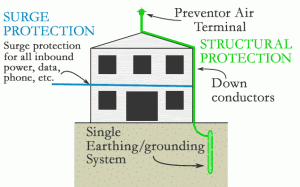Why is this interesting? - The Lightning Edition
On weather, electricity, and the challenge of answering your kid's questions
Amber Finlay (AF) leads product marketing on the SNKRS app at Nike, loves sweaters, and does not currently have lightning protection for her house, so don’t feel bad. She previously contributed the Good Place Edition and Sonic Parenting Edition.
Amber here. Last week while in the car with my kids and the Manhattan skyline in the distance, I received a flurry of questions from my 9-year-old about lightning rods, what buildings have them, and how they work. I gave what turned out to be a wrong-answers-only reply, and repented down a rabbit hole later.
Here’s how a lightning rod works. Like any real estate, location matters most. The rods don’t actually attract lightning, so their placement on tall buildings is more about putting it where lightning is most likely to strike. If the rod takes a direct hit (again, more likely if it’s the tallest thing around), it channels the current around the building and vulnerable electric systems safely to the ground.
(I won’t get into the physics of lightning or injuries a lightning strike could cause here. Thanks to Nick Parish for the scary link).
Benjamin Franklin did, in fact, invent lightning rods, though there’s some debate about whether he flew his kite or not. The rods became a regular addition to structures in the North Eastern US starting in the mid-1700s. Any building can have a lightning rod, though the probability of tall structures being struck is much higher than the average home. I like the way this UK roofing company summarizes the situation: “Lightning rods are the difference between a tall building being struck by lightning safely and the building bursting into flames with everyone inside being electrocuted.” Yikes.
Why is this interesting?
The lightning rod business is comprised of many multi-generational family companies, which makes sense; like railroads, lightning rods have been around for a while. The owner of the Boston Lightning Rod Company says there are a lot of “lightning-protection families” out there, which feels Marvel-esque.
While these companies are old, the lightning-protection game has changed over time based on what can be ruined by a big electrical surge. Lightning rods dissipate direct strikes, which were the main concern for a long time as the buildings themselves had the largest potential for damage. For most of history, there wasn’t a lot within buildings that ran on electricity. But now that our homes and offices are filled with computers, security systems, and lots of other expensive electrical devices, modern lightning protection companies recommend systems that protect against power surges from indirect strikes, often with multiple rods.
Above is the system recommended by a lightning protection company in Florida: the state which has the majority of the most lightning prone cities in the US (and where losing your air conditioner would potentially be the biggest bummer). I took a spin through their gallery, and the lightning rods and systems they install are designed to be very unobtrusive—very thin rods with a rounded ball at the top.
I’d live there.
We’re also looking at a more lightning-y future. A 2014 study found that lightning rates will increase 12 percent per every degree Celsius (about 2°F) rise in global temperatures, adding up to a 50 percent increase by the end of the century. Clearly, this isn’t a major threat and it can be managed, but with every device in increasingly smart homes running off electricity, it could get annoying and expensive. (AF)
Lightning photo of the Day:
Lake Maracaibo in Venezuela has the highest concentration of lightning in the world, and is home to a phenomenon called the Catatumbo lightning. (AF)
_____
Partner post: Brightland x WITI
New year, new resolutions. And one of ours is to re-evaluate the building blocks of our kitchen. One of the best things we’ve switched to last year has been our olive oil. We’re fans of Brightland, a new consumer brand that feels soulful has a clear aesthetic vision and tastes really good. This product is designed to be front and center in your kitchen and with your cooking, a far cry from that dusty green bottle in the back of your cabinet. Brightland is grown in California on family farms, and also fits nearly every lifestyle: vegan, vegetarian, pescatarian, Keto, Paleo, Atkins, and Mediterranean. We are partial to their OG products, Awake and Alive (bought as a duo, of course), but for gourmands, we’d recommend the essential capsule which includes their new champagne vinegar and balsamic vinegar. Your kitchen and cooking will thank you. Brightland offers subscriptions to all of their products, and are kindly offering WITI readers a code for $10 off the Essential Capsule or DUO: WITI10.
_____
Quick Links:
A great New Yorker profile of Cartoon Saloon, an animation studio in Kilkenny, Ireland, that makes gorgeous animated films (The Secret of Kells, Song of The Sea). Apparently, Don Bluth started an independent animation studio in Ireland in the ’80s and set up an animation course at a local college where the Cartoon Saloon founders met. (AF)
A script supervisor at Pixar started putting the percentage of lines for male characters compared with female characters on all her script versions - simple information leading everyone to participate in change. I discovered this on a Twitter thread, but here is the mini-doc it references. (AF)
After a binge of The IT Crowd, try the full Richard Ayoade experience with his series Travel Man - sort of like The Trip with less food, more video games, and IMO funnier. Available on Prime Video, or as my husband calls it based on its Apple TV tile, upside-down Disney Plus. (AF)
Thanks for reading,
Noah (NRB) & Colin (CJN) & Amber (AF)






I don't think the link for "a more lightning-y future" is correct... http://www.fiction-food.com/2015/02/roasted-mushrooms-w-chevre-rosemary.html